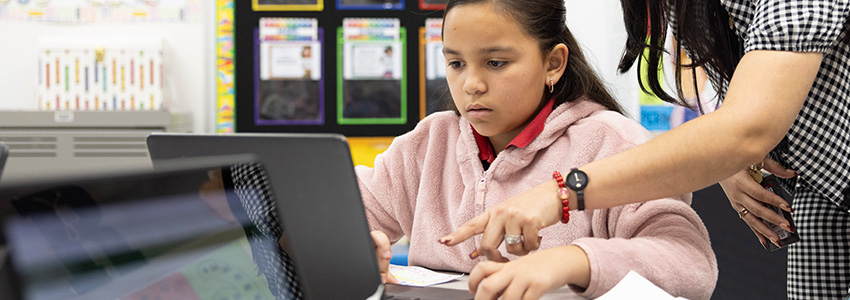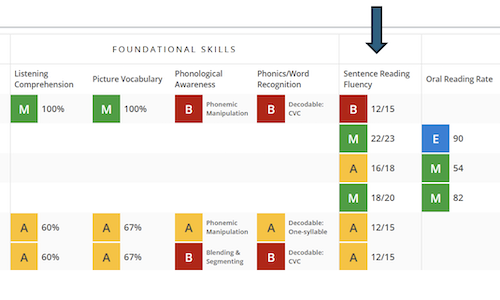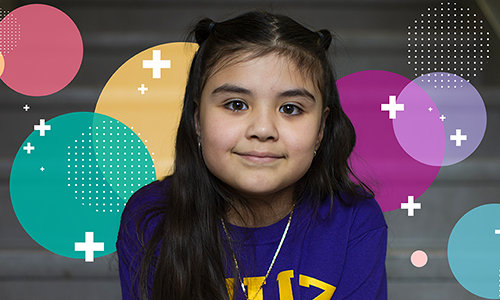 As a teacher of multilingual learners, I have always found the work to be deeply rewarding. Yet choosing which language to assess in—and what to do afterward—can often feel unclear, overwhelming, and intimidating. These feelings have merit, as assessing multilingual learners is deeply nuanced and shaped by the diverse realities of our students’ backgrounds and the systems in which we teach.
As a teacher of multilingual learners, I have always found the work to be deeply rewarding. Yet choosing which language to assess in—and what to do afterward—can often feel unclear, overwhelming, and intimidating. These feelings have merit, as assessing multilingual learners is deeply nuanced and shaped by the diverse realities of our students’ backgrounds and the systems in which we teach.
Some kids arrive in our classrooms as students with limited or interrupted formal education in their home language. Others have a more rigorous education behind them but are newcomers just beginning their journey in US schools while learning a new language and culture. Still others are American-born multilinguals who navigate one language at home and another at school. So what do we do, and how do we find the clarity and confidence to make the right choices?
The reality of our classrooms
Through my years in the classroom, I encountered many situations unique to each learner, layered with all the realities mentioned above. Yet three recurring scenarios surfaced again and again:
- Students who seemed to be progressing in class but whose English test scores remained flat
- Students who entered with little or no English proficiency, making it difficult to know where to begin
- Students who showed limited results in English and, when tested in their home language, also showed the same
Over time, my experience and research helped me make sense of these scenarios and find clarity about why they occur and how to respond. That clarity always stemmed from two essential questions about assessing Spanish speakers in particular that always bring me back to the core purpose of assessment: to enable and reveal what students currently know and can do. Let’s explore these two essential questions, their implications, and the assumptions that can sometimes blur our clarity when making assessment decisions about the Spanish-speaking children in our schools.
Question #1: Has this student received formal academic instruction in Spanish?
Speaking Spanish and learning through Spanish are not the same thing, yet they are often treated as such. A student may speak fluent Spanish at home but have never been taught to read or do math in that language. Understanding this difference is critical because it determines whether you even have a baseline to assess.
Speaking a language does not automatically equate to academic readiness or proficiency in it. We acquire a language naturally through exposure, but we learn it intentionally through instruction. If a language hasn’t been learned intentionally, educators won’t get very far testing in that language. It would be like me taking a mechanics exam full of terms I’ve never formally learned. My everyday English wouldn’t help me much!
This misunderstanding—confusing conversational fluency with academic proficiency—is often what leads educators to puzzling results when assessing multilingual learners. A student whose home language is Spanish may be tested in that language with the hope of seeing stronger performance, only for the results to fall flat. Looking closer, we often find the reason: interrupted learning, limited formal schooling, or no academic foundation in that language at all. Consider the following example.
Student scenario: Miguel
Miguel entered fifth grade in the US after moving from Honduras. His fall English test scores were low, so his teacher decided to test him again in Spanish, hoping to see stronger results. However, his Spanish assessment scores were also flat.
After speaking with his family, Miguel’s teacher learned that early schooling had been inconsistent; Miguel attended school on and off and never received formal instruction in reading or writing in Spanish. While he spoke Spanish fluently at home, he hadn’t developed academic skills in that language. With this context, his teacher realized testing him in Spanish didn’t truly reflect his learning. She shifted to supported English assessments, using visuals, bilingual pairing, content chunking, and small-group settings to build a clearer, more accurate picture of Miguel’s growth.
Question #2: What is my student’s current learning context?
Once you’ve established a student’s academic background and chosen the assessment language, the next step is to define their current learning context. This might include asking questions like:
- Is the student receiving English-only instruction or dual instruction in English and Spanish?
- Is the expectation biliteracy or English proficiency?
This can help you determine what comes after an assessment in Spanish, and whether to continue assessing in Spanish or to focus primarily on English assessments moving forward.
You may find that it all comes down to program type, because that reality shapes everything that follows: state expectations, available resources, and instructional capacity. In multilingual education, two primary models—dual-language and English-focused instructional programs—typically define those realities. Each helps determine whether we cultivate Spanish through continued instruction and assessment or acknowledge and leverage it as a foundation for English development, discontinuing assessment in Spanish when students are ready. Both approaches depend on context and expectations, and both honor the assets students bring to the table.
Dual-language instructional programs: Cultivate
In dual-language programs, students receive instruction in both English and Spanish. They are developing academic proficiency in two languages at the same time, so assessing in Spanish is both valid and necessary.
The goal of these programs is to cultivate: to continue instruction and assessment in Spanish while also strengthening English skills. Using both sets of assessment data allows educators to see how knowledge transfers across languages and to design instruction that nurtures bilingual growth. Dual-language programs are expected to support this balance. With bilingual staffing, resources, and goals that prioritize bilingualism, continued assessment in Spanish alongside English is both feasible and aligned.
Student scenario: Sofía
Sofía is a second grader in a dual-language program where instruction is split evenly between English and Spanish. Her teacher noticed Sofía’s Spanish writing was strong, but her English reading assessments lagged. Because Sofía received academic instruction in both languages, her teacher continued assessing in Spanish to monitor growth and identify what skills were transferring to English. The assessments in Spanish showed strong comprehension skills that could be leveraged during English literacy lessons.
By understanding Sofía’s current learning context—a true dual program—her teacher could cultivate both languages intentionally using bridging concepts during instruction, rather than prematurely focusing on English results only.
English-focused instructional programs: Acknowledge and leverage
In primarily English instructional settings, multilingual students bring a wealth of linguistic and cultural assets but are not receiving ongoing academic instruction in Spanish, especially as dual language opportunities become less common in higher grades. Teachers and resources are specific to only the English language.
Many of these students have an academic foundation in Spanish, either from time spent in a dual-language program or from formal schooling in another country. In this case, understanding their academic background supports the decision to assess in Spanish initially, to establish a baseline for what they already know and how to connect it to their current instruction.
Before sharing a couple examples, I’d like to take a moment to highlight a key distinction: the only time a student should be continuously assessed in Spanish is when they are currently receiving academic instruction in Spanish as part of an active dual-language program. Outside of that setting, that is, in English-focused programs, assessment in Spanish should serve only as a starting point, a way to honor what students bring, before transitioning to English testing, with appropriate scaffolds and support. This is because there are no resources, bilingual teachers, or expectations in the Spanish language to support ongoing academic instruction that would then be tested in that language.
Student scenario: Daniel
Daniel entered the sixth grade after moving from Guatemala. He spoke Spanish fluently at home but had only a few years of interrupted formal schooling before arriving in the US. His new school placed him in an English-only setting, but his teacher continued assessing him in Spanish, assuming it would better reflect what he knew.
Each year, Daniel took Spanish reading and math assessments, yet his English proficiency scores remained unchanged. By tenth grade, he was classified as a long-term English learner, which prompted his teachers to look deeper. They discovered that Daniel had not received any academic instruction in Spanish since arriving here because there were no bilingual teachers, Spanish-language materials, or classroom resources to support that learning. The ongoing Spanish testing hadn’t provided useful information; it had simply masked his need for targeted English language development.
Once the assessments shifted to English only—with scaffolds like bilingual glossaries, visuals, and guided academic language routines—Daniel’s growth became visible for the first time. The experience reminded his teachers that assessments must align with a student’s current instructional reality, not just the language they speak at home.
Student scenario: Walter
Walter arrived in the US in eighth grade and joined a general education setting where all instruction was in English. In Mexico, he had had strong academic Spanish instruction, particularly in math and science.
His teacher began by giving him a short diagnostic in Spanish to gauge what he already knew. The results revealed solid conceptual understanding, even though his English proficiency was still emerging. Using this information, she built lessons that connected prior Spanish knowledge to new English terms, highlighting cognates and using visuals for key vocabulary.
After the initial Spanish baseline, Walter’s teacher transitioned all assessments to English, ensuring scaffolds like bilingual glossaries and extended time were available. The Spanish test wasn’t repeated, but it served its purpose as a bridge to inform English instruction.
The three-scenario flowchart
Assessing in Spanish simply because a student speaks it misses the mark. If students are no longer receiving academic instruction in Spanish, continued testing in that language won’t provide an accurate picture of their learning or growth. As educators, our responsibility is to intentionally prepare students for the skills and expectations ahead—including those measured in English.
Remember the three common recurring scenarios noted at the beginning of this article? Let’s put our two essential questions to the test as we inform and clarify what decisions to make and what comes next.
Students who seem to be progressing in class but whose English test scores remain flat
Question #1: Has this student received formal academic instruction in Spanish?
- If yes, the student has a Spanish academic foundation. Begin with an assessment in Spanish to set a baseline.
- If no, testing in Spanish may not yield actionable results. Ensure English testing has all supports available (e.g., text-to-speech, additional time) as you continue to isolate whether the student is needing extra support with the content or the language.
Question #2: What is my student’s current learning context?
- If you have a dual-language focus, use bridging strategies like aligning tasks to each student’s English proficiency, rather than their Spanish ability. Implement explicit cross-linguistic connections and monitor progress in both languages. You can try strategic peer pairing work with discussions allowed in Spanish during English class activities, for example. Review and practice key English vocabulary terms during learning.
- If your program has an English focus, use baseline insights to target English instruction. Also ensure all testing supports, including accommodations, are in place.
Students who enter with little or no English proficiency, making it difficult to know where to begin
Question #1: Has this student received formal academic instruction in Spanish?
- If yes, start with an assessment in Spanish to see what they know, isolating the variable of content versus language.
- If no, build initial English literacy and classroom routines first. Consider delaying formal English testing until some English instructional exposure has taken place.
Question #2: What is my student’s current learning context?
- If you have a dual-language focus, teach and assess in both languages as you plan intentional transfer (e.g., cognates, parallel texts). Try early informal evidence (e.g., work samples, running records, oral retells) to guide instruction before formal testing.
- If your program has an English focus, provide maximum scaffolds (e.g., text-to-speech, glossaries, small-group proctoring, extended time) during testing.
Students who show limited results in both English and their home language
Question #1: Has this student received formal academic instruction in Spanish?
- If yes, consider possible interrupted or limited formal schooling. Verify their formal learning in Spanish or lack thereof.
- If no, plan to supplement their foundational learning significantly as you continue to honor the learning the student has retained.
Question #2: What is my student’s current learning context?
- If you have a dual-language focus, use bridging to support transfer across languages during instruction and informally assess in both languages to locate precise gaps. Also check for underlying factors (e.g., vision, hearing, processing challenges, missed foundational skills, attendance, placement). Implement targeted foundational skill cycles as you maintain supported English testing to capture growth.
- If your program has an English focus, prioritize English instruction and assessment as the language of ongoing instruction. Scaffold heavily and turn to Spanish to build and anchor meaning.
Learn more
Remember: Effective educators slow down, gather context, and make intentional choices for assessing multilingual learners based on real instructional evidence, not just the language spoken at home.
In dual-language instructional programs, prioritize biliteracy and cultivating a student’s skills in both languages. In English-focused ones, work toward supporting students in making the transition to learning in an English-only academic setting. If a student has not had academic instruction in Spanish—and is not continuously receiving it—acknowledge and leverage their knowledge of Spanish to make connections and build English proficiency. If a student has a foundation of Spanish instruction and is continuously receiving that instruction, cultivate it by continuing to teach and assess in both languages while preparing them for English expectations. In both cases, language isn’t a barrier; it’s a bridge.
To learn more about assessing students in Spanish with MAP® Growth™ and MAP® Reading Fluency™, visit our website.






